Last week Jeanette and I visited the Norman Rockwell Museum in Stockbridge, Massachusetts to see the exhibition called “Lit Graphic: The World of the Graphic Novel,” which is on view through May 26.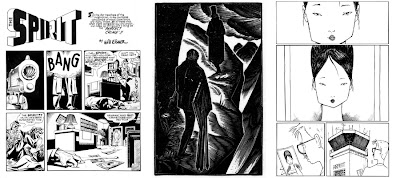 Co-curators Stephanie Plunkett and Martin Mahoney told us that Tom Wolfe invented the term “Lit Graphic” to describe the art form of the contemporary novel-length comic book, which has unfortunately been overlooked by most art museums.
Co-curators Stephanie Plunkett and Martin Mahoney told us that Tom Wolfe invented the term “Lit Graphic” to describe the art form of the contemporary novel-length comic book, which has unfortunately been overlooked by most art museums.
Will Eisner, whose work on the groundbreaking Contract with God is well represented in the show, coined the more familiar term “graphic novel.” Another pioneer was Lynd Ward, who told wordless stories with woodcuts in the 1920s and 1930s. Forty-nine of those delicate images, each separately framed, festoon one wall.
Let me say a word about what is not in the exhibition. There are no French or Japanese comics, no daily or Sunday comic strips, and no Marvel or DC superhero comics. Although most of the works deal with serious, real-world themes, the curators stopped short of exhibiting work that is extremely violent or risqué. But that still leaves a diverse and vital field of talent.
In the room tracing the history of the graphic novels, there are some representative examples by Robert Crumb (including a teenage sketchbook) , but the other two rooms place the emphasis on the contemporary American scene.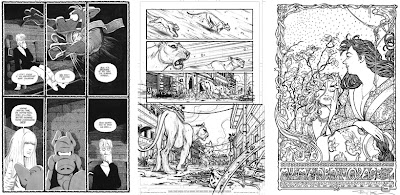 As Mark Wheatley observes, graphic novels are not a genre, but "a language--and it's a visual language." Altogether, there are 146 works by 24 artists, including pages by Peter Kuper, Lauren Weinstein, Harvey Kurtzman, Marc Hempel, Dave Sim, Terry Moore and many others.
As Mark Wheatley observes, graphic novels are not a genre, but "a language--and it's a visual language." Altogether, there are 146 works by 24 artists, including pages by Peter Kuper, Lauren Weinstein, Harvey Kurtzman, Marc Hempel, Dave Sim, Terry Moore and many others.
You can get an online preview of the work and the personalities by viewing the half-dozen mini-documentaries shot on location by producer Jeremy Clowe and recently posted on YouTube:
Part 1: Peter Kuper
Part 2: Marc Hempel
Part 3: Brian Fies
Part 4: Continued
The Rockwell Museum deserves a lot of credit for their pioneering spirit in championing American narrative art in all its forms. In conjunction with the Lit Graphic show, the museum is hosting a student graphic novel contest, inviting high schoolers from the northeastern US to submit their creations. Winners will be honored in a mini-exhibition at the museum. More information: Link.
Norman Rockwell himself explored personal, edgy themes like war and racism in his later career, and he was always supportive of young talent and new graphic ideas. I feel very sure that he would have been pleased to see the huge turnout of young people who attended the opening.
For museums interested in hosting one of the Rockwell Museum's traveling exhibitions (including Dinotopia), Link
Lit Graphic press release: Link
Reading list from TIME: Link
Viewing: Blog Posts Tagged with: Museum Visits, Most Recent at Top [Help]
Results 1 - 7 of 7
Blog: Gurney Journey (Login to Add to MyJacketFlap)
JacketFlap tags: Pen and Ink, Illustrated Books, Comics/Cartooning, Museum Visits, Add a tag
Blog: Gurney Journey (Login to Add to MyJacketFlap)
JacketFlap tags: Museum Visits, Journey to Chandara, Add a tag
 Happy New Year, everyone! And for those of you in Southern California, don't forget that the Dinotopia exhibition at the Los Angeles Public Library will be up only through this Sunday. For more info, check the LAPL or Dinotopia sites.
Happy New Year, everyone! And for those of you in Southern California, don't forget that the Dinotopia exhibition at the Los Angeles Public Library will be up only through this Sunday. For more info, check the LAPL or Dinotopia sites.
Blog: Gurney Journey (Login to Add to MyJacketFlap)
JacketFlap tags: Museum Visits, road tour, Add a tag
The Museum of Jurassic Technology in Culver City, California, is a curio cabinet of obscure relics and extinct beliefs. "Jurassic" is metaphorical; no dinosaurs here.
We wandered in late on a drizzly day. No one else was there. A bearded attendant finally appeared from nowhere. He apologized for the smell of a dog-doo and incense (a dog had just had an accident). He directed us to watch an introductory slide show in a shrine-like alcove.
A voice began in sonorous tones describing how the word “museum” should be a place dedicated to the muses. We explored the dark, narrow rooms and hallways, passing through doorways framed with heavy Victorian curtains. The displays included.
- Micromosaics made from the scales of butterly wings.
- Stereo floral radiographs of Albert Richard.
- Vectography (an obscure 1940s technique for overlapping 3-D images)
- Microminiature figures carved by Hagop Sandaldjian, figures so small they easily fit inside the eye of a needle.
- A bell wheel, known as an arca musarithmica,
- And displays of forgotten folk cures, like two dead mice on a piece of toast given to a child to cure stuttering.
“Teaching,” quoting 18th Century museum pioneer Charles Willson Peale, “is a sublime ministry inseparable from human happiness. The learner must be led always from familiar objects toward the unfamiliar - guided along, as it were, a chain of flowers into the mysteries of life.”
Fodor's Review of the Museum
Blog: Gurney Journey (Login to Add to MyJacketFlap)
JacketFlap tags: Museum Visits, road tour, Journey to Chandara, Add a tag
Today the Oshkosh Public Museum opened its exhibition of 49 original paintings from Dinotopia: Journey to Chandara.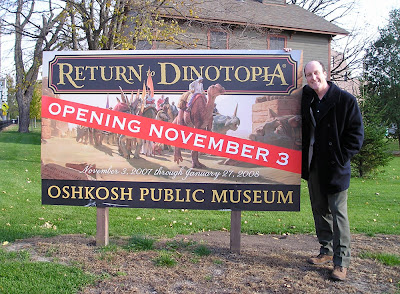 Here’s the sign outside museum. There were also buses with Dinotopia banners, local school events, a signing at the Apple Blossom Bookstore, and reading lists at the library, thanks to the tireless organizing efforts of the museum’s assistant director Mike Breza and members of the community here in Oshkosh, Wisconsin.
Here’s the sign outside museum. There were also buses with Dinotopia banners, local school events, a signing at the Apple Blossom Bookstore, and reading lists at the library, thanks to the tireless organizing efforts of the museum’s assistant director Mike Breza and members of the community here in Oshkosh, Wisconsin. Performers from the Cirque du Soleil were present in costumes that matched the “Liners” illustration from the Dinotopia book. Here they are posing next to the original painting “Spotters and Liners.”
Performers from the Cirque du Soleil were present in costumes that matched the “Liners” illustration from the Dinotopia book. Here they are posing next to the original painting “Spotters and Liners.”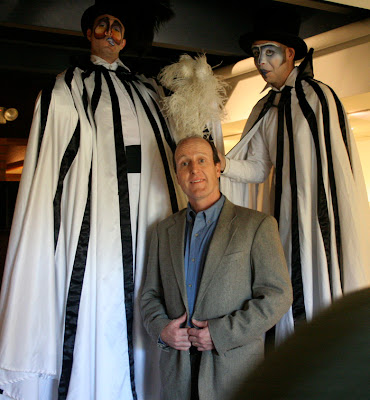 The stiltwalkers made an impressive sight as they walked nimbly up and down the grand staircase, while jugglers managed up to five pins in the lobby.
The stiltwalkers made an impressive sight as they walked nimbly up and down the grand staircase, while jugglers managed up to five pins in the lobby.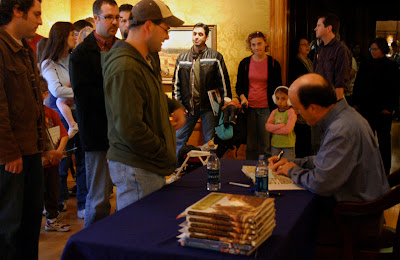 Thanks to everyone at the museum and to all of you who came to say hello and have your books signed. I’m especially grateful for those of you who drove from far away to attend the opening.
Thanks to everyone at the museum and to all of you who came to say hello and have your books signed. I’m especially grateful for those of you who drove from far away to attend the opening.
Blog: Gurney Journey (Login to Add to MyJacketFlap)
JacketFlap tags: Museum Visits, Add a tag
The Museum of Fine Arts in Boston had a puzzle to solve.
Curators had always suspected that Bernardo Strozzi’s painting of Saint Sebastian, acquired in 1972, had at some earlier time been hacked down from its original size. The painting must have been incomplete because the saint was reaching heavenward and yet there was nothing in the composition above him. When the museum received a call that the missing top half of the painting had been located, they wanted to reunite the two pieces. But that meant that Andrew Haines, the museum’s conservator of framing, would have to chuck the old picture frame and create a whole new one to match the period of the 17th century painting. Haines and his staff constructed a special frame with a black divider to artfully disguise the gap between Sebastian and the angels.
But that meant that Andrew Haines, the museum’s conservator of framing, would have to chuck the old picture frame and create a whole new one to match the period of the 17th century painting. Haines and his staff constructed a special frame with a black divider to artfully disguise the gap between Sebastian and the angels.
Haines is one of only about five full-time picture frame conservators in America. My wife Jeanette and I visited him yesterday morning in a workroom deep in the bowels of Boston’s beloved MFA. He and his assistants were painstakingly restoring a large frame from a Courbet (left), using dental molding material to cast missing chunks of ropelike relief elements. Repairing this one frame required the labor of three people working full time for three weeks.
He and his assistants were painstakingly restoring a large frame from a Courbet (left), using dental molding material to cast missing chunks of ropelike relief elements. Repairing this one frame required the labor of three people working full time for three weeks.
“A fun aspect of this job is that we get to see a painting in different frames,” he told us. Each period of art history had its own unique sensibility for framing. But all the fancy gold styles ultimately trace back to the decorative bling prized by the church in the middle ages. “European painting comes out of the Catholic church,” he said, and so do the frames. "Before the Renaissance, painters, carpenters, and gilders were all seen as craftsmen of equal stature, all working together as contractors to make altarpieces," he said.
Haines rolled out the storage dividers in the painting collection to show us how the history of frames mirrored the history of art.
Frames for American paintings, for example, often included decorative motifs from nature, like leaves and flowers. Here, Adeline is painstakingly using purified water to clean the gilded decoration that once graced a painting by Fitz Henry Lane (formerly known as Fitz Hugh Lane). Jeanette and I first met Andrew Haines in his second life as a realist painter. We attended the opening of his one man show at the George Billis gallery on October 11.
Jeanette and I first met Andrew Haines in his second life as a realist painter. We attended the opening of his one man show at the George Billis gallery on October 11.
Mr. Haines gets up at six in the morning, sees his kids off to school, and then paints his own pictures for a couple hours before riding his bicycle to work at the museum. Take heart, you painters in spare hours!
His own paintings are breathtaking in their Hopperesque simplicity and mood. His mastery of light, color, and composition clearly grows out of the close working knowledge of art that he receives every day at the MFA.
Blog: Gurney Journey (Login to Add to MyJacketFlap)
JacketFlap tags: Museum Visits, Add a tag
Blog: Gurney Journey (Login to Add to MyJacketFlap)
JacketFlap tags: Watercolor Painting, Museum Visits, Painting Gear, Academic Painters, Add a tag
We had the day off in Baltimore yesterday, so we spent most of the day in the Walters Art Museum. This is a must-see collection if you like 19th Century academic painting, and they also have a vast collection of Asian, Egyptian, and Roman stuff on display. And it’s free! Check out this gem “Figaro’s Shop” by the Spanish genre painter Jose Aranda 1837-1903.I also inaugurated a new Moleskine mini watercolor sketchbook. The view is of Vernon Square Park from the steps of the Peabody Conservatory.
As usual, I picked a motif that was way too complex, so I was boggling my brain trying to sort it all out. I took a couple of shots in progress: I tried to simplify things by using a limited palette: lampblack, ultramarine blue, yellow ochre, vermillion, and sepia. After a quick pencil drawing, the first step was to block in the main shapes with a ½ inch Winsor & Newton series 995 flat.
I tried to simplify things by using a limited palette: lampblack, ultramarine blue, yellow ochre, vermillion, and sepia. After a quick pencil drawing, the first step was to block in the main shapes with a ½ inch Winsor & Newton series 995 flat. After this rough block-in I like to add the finicky details with a brown fountain pen. But I left it in the hotel room, so I used an Escoda 1212 Kolinksy round #4 instead. The water supply is from a clear 35mm film can. Remember film cans?
After this rough block-in I like to add the finicky details with a brown fountain pen. But I left it in the hotel room, so I used an Escoda 1212 Kolinksy round #4 instead. The water supply is from a clear 35mm film can. Remember film cans?



I went before I left town for break. Fun stuff! It was really cool to see the paintings in real life - it's different than seeing them printed.
It was fun to see a lot of the examples you've talked about on this blog in real life.
Happy New Year to you and your family! And congratulations on the one year anniversary of the OMB at the proboards server. =)
Breathe Deep Seek Peace, Vorchia
And thanks to you, Nathalie and to Azonthus for your tireless efforts in looking after the Official Dinotopia Message Board. It's best place to go (short of Waterfall City itself) to talk with other Dinotopians.
Follow the NEW link off the blog or go to http://ombdinotopia.proboards88.com/index.cgi